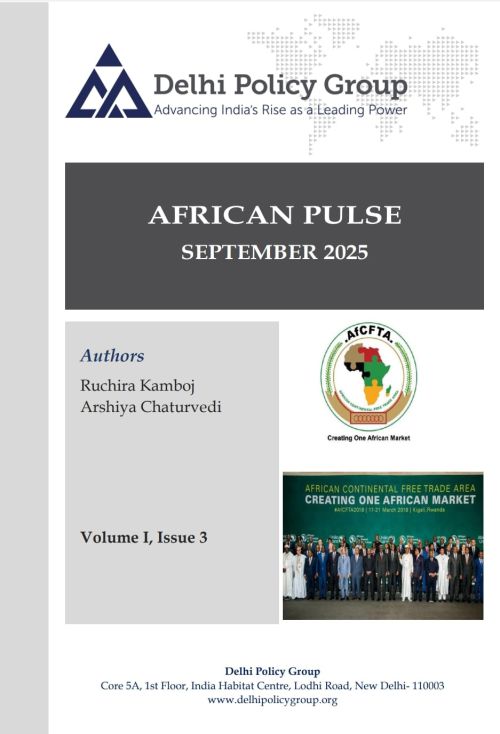African Pulse
This monthly focuses on studies of strategic and economic security-related developments in Africa, which hold particular relevance for India. In this issue, the authors examine the potential of the AfCFTA in unlocking Africa’s next growth frontier.
The African Continental Free Trade Area (AfCFTA), with its Secretariat headquartered in Accra, was launched in 2019 and has been signed by 54 of 55 AU member states and ratified by 48. Covering a market of 1.3 billion people, it has rightly been hailed as a “game changer” and Africa’s “most consequential undertaking,” with the eventual promise of transforming a fragmented trade landscape into a single, integrated market.
At its core, the AfCFTA seeks to grow intra-African trade, reduce dependence on external partners, and build a continental value chain that can drive industrialisation and resilience. By harmonising rules and lowering barriers, the Agreement aims to shift Africa’s growth model from raw commodity exports to diversified production and trade. The ambition is clear: a continent trading with itself at scale, competing globally as one.
Implementation has been uneven, but progress is visible. Eight pilot countries have begun trading under AfCFTA rules. Intra-African trade has edged upward, reaching US$192 billion in 2023, 14.9% of total African trade, up from 13.6% the previous year. Yet the base remains low, and in many cases trading within Africa is still more expensive than trading externally. Payment systems such as the Pan-African Payment and Settlement System (PAPSS) have been launched, but require rapid scaling to deliver meaningful impact.
The obstacles are structural and persistent: inadequate infrastructure, regulatory divergence, tariff and non-tariff barriers, and low productive capacity. Industrial supply chains remain shallow, and the ability to scale up production for a continental market is limited. Without credible improvements in infrastructure and logistics, AfCFTA’s promise risks under-delivery. As in many such undertakings, the key lies not in the design but in implementation.
To back AfCFTA, the AU has put in place complementary frameworks: the Action Plan for the Accelerated Industrial Development of Africa (AIDA) to strengthen industrial capacity, and the Comprehensive Africa Agriculture Development Programme (CAADP), launched in 2003, to raise productivity and food security. These are functional, but progress has lagged behind ambition. Without a stronger political push and resource mobilisation, Africa’s productive base will remain thin.
The coming years will be decisive. The architecture is in place, pilots are operational, and early trade flows have begun. What is needed now are visible wins for African businesses and consumers: lower trade costs, smoother customs, interoperable payments, and clear benefits on the ground. Without these tangible results, AfCFTA risks becoming aspirational rather than transformational, while progress could reset Africa’s growth trajectory.
India is well positioned to partner African nations and the AU in this journey. Through the India-Africa Forum Summits, the ITEC programme, and flagship initiatives such as the Pan-African e-Network, India has built credibility as a development partner. It now also ranks as Africa’s third-largest trading partner. As AfCFTA enters Phase III, focused on digital trade, India’s proven Digital Public Infrastructure (DPI) platforms - Indiastack, UPI, and Aadhaar-based services - can provide scalable solutions. India should step up efforts to build on deep bilateral ties to engage at the continental level, not only as a leading partner but also as a co-developer of Africa’s emerging single market.
To read this African Pulse, Vol. I, Issue 3, please see the PDF attached.



